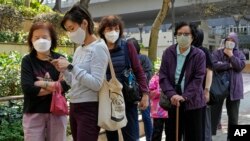Hong Kong hit a record 56,000 COVID-19 cases on Thursday, but the city’s leader denied a “wholesale” lockdown was looming.
Earlier this week, domestic media reported that such a lockdown was imminent in efforts to enforce the Hong Kong government's recent decision to conduct compulsory mass testing for each resident this month.
The Sing Tao Daily, Hong Kong’s oldest Chinese language newspaper, reported that the testing would start March 17, followed by a lockdown, citing unidentified sources.
But for the second time in recent weeks, Hong Kong Chief Executive Carrie Lam reiterated there would not be a "wholesale" lockdown, despite soaring cases of the omicron variant of the coronavirus that continues to overwhelm the city’s health system, local media reported.
The mixed messaging comes after Health Secretary Sophia Chan told reporters on Monday that authorities were still “considering” a lockdown plan.
Dr. David Owens, an honorary assistant clinical professor at Hong Kong University, said having a lockdown in mid-March would make “no sense.”
“The timing of lockdown in this context depends on the strategy and reasons. If the goal is to drastically cut transmission to bring the epidemic under control, then the optimal time was two months ago. If we were to do it now, there may be a small benefit, but even then delaying two weeks would reduce that small benefit further, so it makes no sense,” Owens told VOA.
Several health experts have agreed that the peak of Hong Kong’s fifth wave, caused by the highly transmissible omicron variant, is due to be reached in the first weeks of March.
“My point to this is that we are already living with COVID-19. By then and to pursue zero-COVID when you already effectively have population immunity makes no sense,” Owens added.
Since the pandemic began two years ago, Hong Kong has adopted a “zero-COVID” strategy, aligned with Beijing's effort to control infections across China. The strategy has had some success, with authorities quickly clamping down on rare outbreaks by contact tracing, social restrictions, mass testing and quarantine.
But this year alone, Hong Kong has seen more cases than 2020 and 2021 combined, leaving authorities in an unprecedented health crisis.
On Thursday, Hong Kong recorded a daily high of 56,827 new infections, with 144 deaths. Three-hundred-and-50-thousand-557 positive cases have been recorded, with 1,312 deaths at last report.
Concerned residents say they believe a mainland-style lockdown could be announced soon. China enforced harsh lockdowns at the beginning of the pandemic in efforts to contain cases, with streets empty and citizens prohibited from leaving home.
Many Hong Kong residents have been shopping frantically in supermarkets in recent weeks, stocking up on food and resources, leaving shelves empty.
On Thursday, Dr. Chui Tak-yi, Hong Kong’s food and health secretary, played down fears of a supply shortage in the city, telling reporters there was no need for residents to resort panic buying.
According to a survey, however, 90% of the responses would welcome a citywide lockdown, coupled with the universal testing plan. The pro-Beijing political party, the Democratic Alliance for the Betterment and Progress of Hong Kong, conducted the survey and received responses from more than 13,000 citizens, The Standard newspaper reported.
Ben Cowling, chair professor of epidemiology at the University of Hong Kong’s School of Public Health, tweeted that if health authorities immediately imposed a lockdown, it would save more lives than doing so during the mass testing dates.
“A lockdown now for 2 weeks would save many more lives than a lockdown in late March that is implemented to facilitate contact tracing during mass testing cycles. More stringent social distancing now, for two weeks, would slow down transmission as we approach the peak,” Cowling tweeted on Monday.
Late last month, Lam announced a universal testing program for the entire 7.4 million population for March, with each resident undergoing three tests.
Local media have reported the universal testing plan will begin on March 26 and last nine days. City health experts have said March is too early because the infection numbers are still high.
Professor Gabriel Leung is the dean of medicine at the University of Hong Kong, HKU. Citing data in an updated study from the school, he said that if the government wants to achieve a “zero-COVID” policy, it would be better for mass testing to begin next month instead.
“…If compulsory universal PCR testing were to be implemented under “dynamic zero-covid policy”, it should be deployed mid-to late-April when case numbers will already be at very low levels in order to truly achieve elimination or “zero covid,” Leung tweeted.
Already overworked and short-staffed, one health worker at Hong Kong’s United Christian Hospital told VOA she was “afraid” of the mass testing plan.
“I am so afraid of the universal testing program. We don’t have enough manpower for that. The government is so keen on a zero-COVID strategy. To me, it is a zero-medical staff strategy. The morale is worsened every day in the front line.”
February saw shocking scenes outside several Hong Kong hospitals, as dozens of sick patients lay in beds in cold weather waiting to be admitted. According to recent data from the Hong Kong Hospital Authority, public hospitals in the city were close to full capacity.
The study by medical researchers at the University of Hong Kong suggests the city could face nearly 7,000 deaths in the next three months if hospitals were to be overburdened.
The overflow of Hong Kong’s medical facilities has led to the city contracting construction firms from China to build isolation and treatment facilities in Hong Kong, with space for a reported 50,000 beds.







